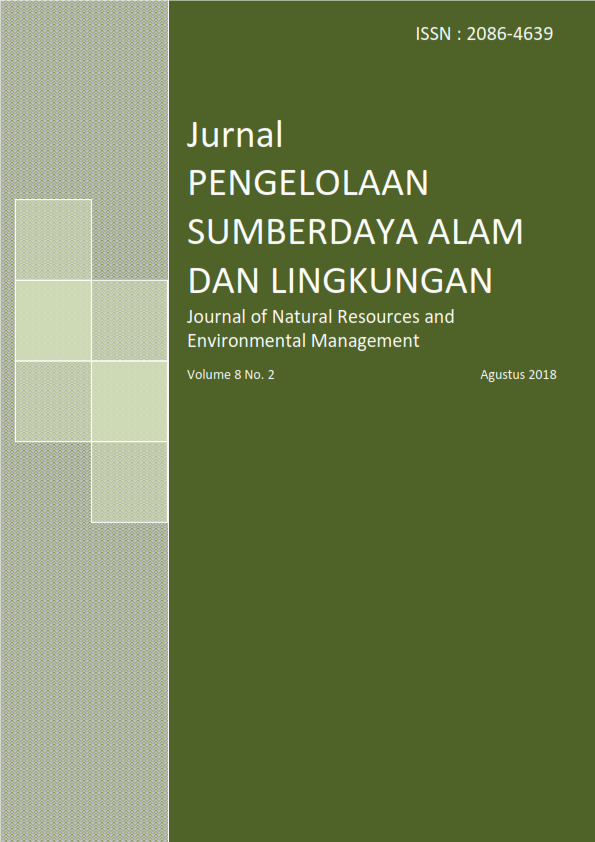ARAHAN KEBIJAKAN MITIGASI PADA ZONA RAWAN BANJIR KABUPATEN LIMAPULUH KOTA, PROVINSI SUMATERA BARAT
Abstract
Indonesia is a country that has a wet tropical climate, so that about 60 % of the cities in Indonesia is very a hazard to flood. The floods have caused many losses to humans. The purpose of this study is determine the direction of development policy mitigation of flood hazard zones in Limapuluh Kota District, by using GIS analysis with the overlay technique. The indicators used to determine the flood hazard zones are rainfall, slope, landform, soil type, geology, elevation, and land use. Mitigation policy directives using AHP analysis involving 15 experts with conservation criteria, regulations, community capacity. The results showed 6,2 % is a very flood zone. Three main landing to reduce the impact of floods is disaster education, improved socialization in flood hazard zones, and planning of based spatial disaster.
References
Bechtol V, Laurian L. 2005. Restoring Straightened Rivers for Sustainable Flood Mitigation. Disaster Prevention and Management. 14(1), pp, 6-19.
[BMKG] Badan Meteorologi Klimatologi dan Geofisika Sicincin, 2017. Data curah hujan periode 1975-2017. BMKG Sicincin, Sicincin.
[BNPB] Badan Nasional Penanggulangan Bencana. edoman Umum Penanggulangan Resiko Bencana, Jakarta.
[BPBD] Badan Penanggulangan Bencana Daerah Kabupaten Limapuluh Kota, 2017. Catatan Kebencanaan Daerah. BPBD Kab. Limapuluh Kota, Limapuluh Kota.
El-Kadi, A., E. Yamashita, 2007. Modeling Streamflows and Flood Delineation of the 2004 Flood Disaster. Manoa, O'ahu, hawai'i1. Pacific Science. 61(2), pp. 235-238.
Gharagozlou, A., H. Nazari, M. Seddighi, 2011. Spatial Analysis for Flood Control by Using Environmental Modeling. Journal of Geographic Information System, 3(4), pp. 367-372.
Karmakar, S., S. Simonovic, A. Peck, J. Black, 2010. An Information System for Risk-Vulnerability Assessment to Flood. Journal of Geographic Information System. 2(3), pp. 129-146.
Kaur, E., H. Palang, H. Soovali, 2004. Landscapes in Change-Opposing Attitudes in Saaremaa, Estonia. Landscape and Urban Planning. 67, pp. 109-120.
Kodra, H.S.A., dan Syaurkani., 2004. Bumi Makin Panas Banjir Makin Luas. Penerbit Yayasan Nuasa Cendikia, Bandung.
Kodoatie, R., 2013. Rekayasa dan Banjir Kota. Penerbit ANDI, Yogyakarta.
Kunreuther, H., 2008. Reducing Losses from Catastrophic Risks Through Long term Insurance and Mitigation. Social Research. 75(3), pp. 905-930.
Marimin, dan Maghfiroh, N., 2010. Aplikasi Teknik Pengambil Keputusan dalam Manajemen Rantai Pasok. IPB Press, Bogor.
Mudelsee, M., M. Borngen, G. Tetzlaff, U. Grunewald, 2003. No Upward Trends in The Occurrence of Extreme Floods in Central Europe. Nature, 425(6954), pp. 1-9.
Muta'ali, L., 2012. Daya Dukung Lingkungan untuk Perencanaan Pengembangan Wilayah. Badan Penerbit Fakultas Geografi (BPFG) Universitas Gadjah Mada, Yoyakarta.
Penning-Rowsell, E., 2003. Flood Hazard Response in Argentina. Geographical Review. 86(1), pp. 72-90.
Popovska, C., M. Jovanovski, D. Ivanoski, I. Pesevski, 2010. Storm Sewer System Analysis In Urban Areas and Flood Risk Assessment. Technical University of Civil Engineering from Bucharest.75(3), pp. 95-110.
Pribadi, D., D. Shiddiq, M. Ermyanila, 2006. Model Perubahan Tutupan Lahan dan Faktor-Faktor yang Mempengaruhinya. Jurnal Teknologi Lingkungan BPPT. 3 (1), pp. 77-91.
[RI] Republik Indonesia, 2007. Undang-Undang No 24 Tahun 2007 tentang Penanggulangan Bencana. Lembaran Negara RI Tahun 2007, No 68. Sekretariat Negara, Jakarta.
Stoica, A., I. Iancu, 2011. Flood Vulnerability Assesment Based on Mathematical Modeling. Technical University of Civil Engineering from Bucharest. 425(69), pp. 1-9.
Suripin, 2004. Sistem Drainase Perkotaan yang Berkelanjutan. Penerbit ANDI, Yogyakarta.
Sadyohutomo, M., 2008. Manajemen Kota dan Wilayah Realitas dan Tantangan. Penerbit Bumi Aksara, Jakarta.
Umar, I., 2016a. Mitigasi Bencana Banjir pada Kawasan Permukimann Di Kota Padang (disertasi). Bogor, Sekolah Pascasarjana IPB.
Umar, I., Widiatmaka, B. Pramudya, dan B. Barus, 2006b. Delineation of Flood Harzad Zones by Using a Multi Criteria Evaluation Approach in Padang West Sumatera Indonesia. Journal of Enviroment and Earh Science. 4(3), pp. 27-34.
Wardhono, A., G. Pratomo, B. Prakoso, C. Qori'ah, 2012. Countermeasures Flood Disaster Sampean River Policy in Situbondo District. Journal of Law and Social Sciences (JLSS). 2(1), pp. 118-122.
Yang, M., X. Qian, Y. Zhang, J. Sheng, D. Shen, Y. Ge, 2011. Spatial Multicriteria Decision Analysis of Flood Risks in Aging-Dam Management in China. International Journal of Environmental Research and Public Health. 8(5), pp. 1368-1387.
Yüksek, O., M. Kankal, O. Üçüncü, 2013. Assessment of Big Floods in the Eastern Black Sea Basin of Turkey. Environmental Monitoring and Assessment. 185(1), pp. 797-814.
Authors
Authors who publish with this journal agree to the following terms:
- Authors retain copyright and grant the journal right of first publication with the work simultaneously licensed under a Creative Commons Attribution License that allows others to share the work with an acknowledgement of the work's authorship and initial publication in this journal.
- Authors are able to enter into separate, additional contractual arrangements for the non-exclusive distribution of the journal's published version of the work (e.g., post it to an institutional repository or publish it in a book), with an acknowledgement of its initial publication in this journal.
- Authors are permitted and encouraged to post their work online (e.g., in institutional repositories or on their website) prior to and during the submission process, as it can lead to productive exchanges, as well as earlier and greater citation of published work (See The Effect of Open Access).





